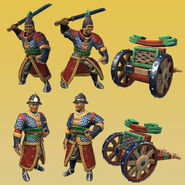The Hwacha is a unique ranged unit of the Korean civilization in Civilization VI: Rise and Fall. It replaces the Field Cannon and is unlocked with Gunpowder.
- Common abilities:
- -17
 Ranged Strength against
Ranged Strength against  District defenses and Naval units.
District defenses and Naval units.
- -17
- Special abilities:
- Special traits:
- Lower
 Production cost (250 vs. 330).
Production cost (250 vs. 330). - Lower
 Combat Strength (45 vs. 50).
Combat Strength (45 vs. 50). - Lower
 Gold maintenance cost (3 vs. 5).
Gold maintenance cost (3 vs. 5).
- Lower
Strategy
The Hwacha is an average unique unit, neither weak and forgettable nor outstanding and memorable. It has the same ![]() Ranged Strength as and lower
Ranged Strength as and lower ![]() Combat Strength,
Combat Strength, ![]() Production, and
Production, and ![]() Gold maintenance costs than the Field Cannon, and is available an entire era earlier. It also, like a siege unit, cannot attack after moving unless it has at least 2
Gold maintenance costs than the Field Cannon, and is available an entire era earlier. It also, like a siege unit, cannot attack after moving unless it has at least 2 ![]() Movement left. This restriction can be bypassed if it starts its turn next to a Great General, but the Koreans' lack of incentives to build Encampments make them unlikely to earn Great Generals, so they will most likely be limited to using the Hwacha as a defensive unit.
Movement left. This restriction can be bypassed if it starts its turn next to a Great General, but the Koreans' lack of incentives to build Encampments make them unlikely to earn Great Generals, so they will most likely be limited to using the Hwacha as a defensive unit.
The earlier availability of the Hwacha, however, can work to Korea's advantage. The Koreans' bonuses to ![]() Science output allow for unparalleled technological advancement, so if they have strong
Science output allow for unparalleled technological advancement, so if they have strong ![]() Production potential in their cities and/or a lot of extra
Production potential in their cities and/or a lot of extra ![]() Gold, they can potentially surprise their neighbors with a legion of Hwachas at their doorstep. Both players who play as and against Korea tend to overlook how early the Hwacha can be unlocked, so a surprise war with this unit can yield a good result.
Gold, they can potentially surprise their neighbors with a legion of Hwachas at their doorstep. Both players who play as and against Korea tend to overlook how early the Hwacha can be unlocked, so a surprise war with this unit can yield a good result.
Civilopedia entry
The Korean hwacha (or “fire chariot”) launched the most terrifying fireworks display of the 15th Century. At first glance, this simple, two-wheeled wooden cart bears little more than a slotted horizontal board as its cargo. When fully loaded and fired, dozens of rocket-propelled projectiles would streak out from those slots, raining a steel-tipped volley upon distant enemy formations.
This efficient death machine came to prominence when it helped repel a late 16th Century Japanese invasion of Korea. The hwacha presence at the Battle of Haengju significantly aided the 3,400 Korean defenders against an invading samurai infantry nine times their size.
Gallery
See also
- Hwacha in other Civilization games


